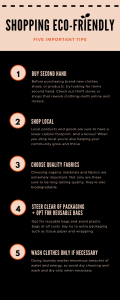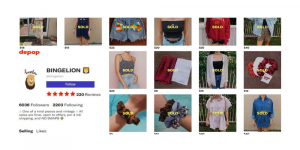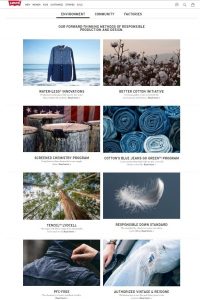The fashion industry produces about 1 billion garments annually. This creates 1.2 billion tons of carbon dioxide per year. That’s five percent of global emissions, which is more than is coughed up by air travel and international shipping.
The fast fashion industry is also responsible for producing 20% of global wastewater, which results in the contamination of rivers, oceans, freshwater, and soil. That’s all according to 7Billion for 7Seas, one of Canada’s most popular sustainability organizations.
There’s more. The average consumer damages the environment by throwing out old or worn-out clothes and fabrics instead of donating them.

“North Americans send 10.5 million tons of clothing to the landfill each year—that’s 30 times heavier than the Empire State Building,” said global movement Fashion Revolution. “In landfills, the decomposing clothes release methane, a harmful greenhouse gas. Meanwhile, synthetic fabrics like polyester and lycra take hundreds of years to biodegrade.”
So what can consumers do to help the environment and force a change in the industry?
Buying clothes second hand, shopping local, choosing quality fabrics, and steering clear of packaging are just a few of the many activities that consumers can practice to support sustainability in the fashion world.
“It’s essential to help consumers understand why and how to improve their shopping habits—not to stop supporting fashion altogether,” said Broward College student Vicky Salazar.
Ella Terran is a huge advocate for buying second hand and shopping locally. The West Broward High School senior combined her love of fashion and sustainability by creating her own second hand, vintage clothing brand: Bingelion.
Terran designs and sells vintage, one of a kind pieces from clothes and fabrics she finds at thrift shops like Goodwill. This method is known as “reworking.”
“Reworking is a form of upcycling in which one gives an old piece of clothing a new life. When you rework old clothing, you’re basically adding something to it in order to make it trendy or wearable,” said Terran. “This can be as simple as cutting an old t-shirt or adding rips to a pair of worn-out jeans.”
Apart from creating clothes and accessories, Terran also designs novelties such as scrunchies and pencil pouches. Her creativity garnered over 6,000 followers on the shopping app dubbed Depop.
“It’s imperative that consumers give second-hand stores a chance,” said Terran. “Thrift shopping helps save the planet one garment at a time.”
“Aside from thrifting, making a conscious effort to shop eco-friendly is so important. Shop local, use reusable bags, and donate old clothing (or rework/reuse it),” said Terran. “There are stores like Plato’s Closet and Clothes Mentor that will even pay consumers for donations. Sustainability is the future of fashion, and it’s up to us, consumers and producers alike, to make this possible.”


While shopping second hand may not be a step that all consumers are willing to take just yet, there are clothing brands that offer consumers both sustainable and fashionable products.
Everlane, Reformation, One of a Kind, Able, People Tree, and Levi’s have created green initiatives and offer consumer eco-friendly products. Levi’s has saved more than 3 billion liters and recycled more than 2 billion liters of water. Today, more than 70% of all Levi’s products are made with Water<Less® techniques. The firm is also working with Cotton’s Blue Jeans Go Green™ program to turn old denim into insulation for homes and buildings.
“Since launching in 2006, Cotton’s Blue Jeans Go Green™ program has helped retailers, colleges and organizations recycle over 2.4 million pieces of denim and diverted over 1,200 tons of textile waste from landfills. The program has provided insulation to over 40 Habitat for Humanity affiliates and more than 15 civic-oriented buildings across the U.S.,” states the brand.

Yet it’s no secret that most shops are on the costly side. While some products are priced at $50, most brands sell single items for up to $150.
For this reason, many consumers just can’t afford the shift from fast fashion to eco-friendly.
Luckily, there are alternatives. Fast fashion brands such as Columbia and H&M have eco-friendly initiatives.
In 2009, H&M released an initiative called Conscious. The line features products that are created and produced solely through green practices.
As a member of the Better Cotton Initiative, H&M also offers a recycling program in which customers return old clothes from any brand in-store and receive discounts and benefits. The program has allowed H&M to create the Conscious line from sustainable materials and recycled clothing and fabrics.
H&M Conscious is a great alternative for consumers because it’s ethical and affordable. Unlike most other green brands, the products in H&M’s Conscious line are trendy, high quality, and range from $20 to $200. And shoppers can browse from their living rooms.

While shifting towards sustainability may seem tricky, it’s important for consumers to understand that in this age, every person can create positive change. It’s up to consumers to make the industry listen and show them that sustainability can be the future of fashion.
































